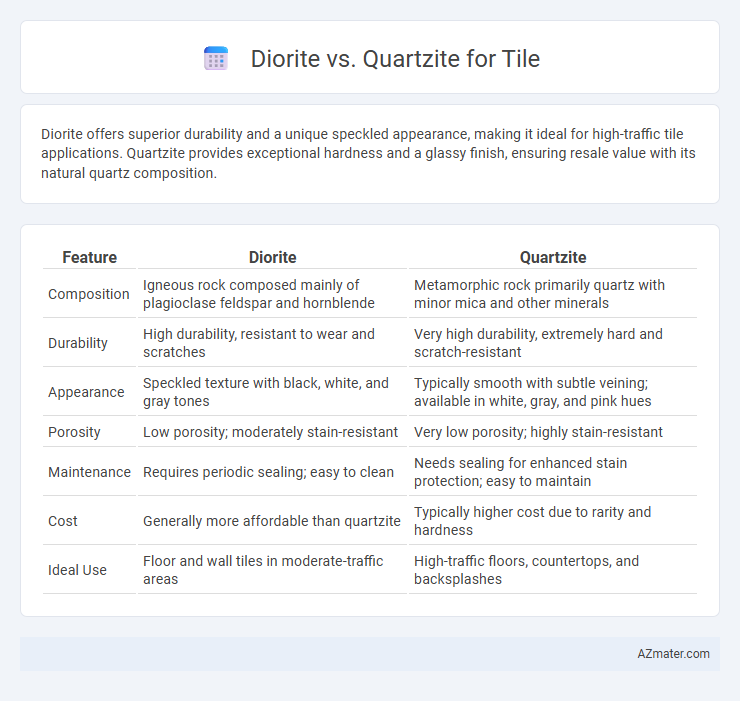Diorite offers superior durability and a unique speckled appearance, making it ideal for high-traffic tile applications. Quartzite provides exceptional hardness and a glassy finish, ensuring resale value with its natural quartz composition.
Table of Comparison
| Feature | Diorite | Quartzite |
|---|---|---|
| Composition | Igneous rock composed mainly of plagioclase feldspar and hornblende | Metamorphic rock primarily quartz with minor mica and other minerals |
| Durability | High durability, resistant to wear and scratches | Very high durability, extremely hard and scratch-resistant |
| Appearance | Speckled texture with black, white, and gray tones | Typically smooth with subtle veining; available in white, gray, and pink hues |
| Porosity | Low porosity; moderately stain-resistant | Very low porosity; highly stain-resistant |
| Maintenance | Requires periodic sealing; easy to clean | Needs sealing for enhanced stain protection; easy to maintain |
| Cost | Generally more affordable than quartzite | Typically higher cost due to rarity and hardness |
| Ideal Use | Floor and wall tiles in moderate-traffic areas | High-traffic floors, countertops, and backsplashes |
Introduction to Diorite and Quartzite Tiles
Diorite tiles are composed of coarse-grained igneous rock formed from the slow crystallization of magma, featuring a distinctive salt-and-pepper appearance with durable hardness ideal for heavy-traffic areas. Quartzite tiles originate from metamorphosed sandstone, known for their high quartz content that delivers exceptional strength, resistance to abrasion, and a glassy sheen perfect for both indoor and outdoor flooring. Both tile types offer superior durability and unique aesthetic qualities, making them popular choices in modern architectural design.
Geological Origins of Diorite and Quartzite
Diorite is an intrusive igneous rock formed from the slow crystallization of magma beneath the Earth's surface, characterized by a coarse-grained texture composed mainly of plagioclase feldspar and hornblende. Quartzite originates as a metamorphic rock formed from the recrystallization of sandstone under intense heat and pressure, resulting in a dense and durable material primarily composed of quartz. The geological origins of diorite and quartzite influence their distinct hardness, texture, and suitability for tile applications in construction and design.
Physical Properties Comparison
Diorite is a coarse-grained igneous rock composed mainly of plagioclase feldspar and hornblende, known for its durability and hardness typically ranging between 6 and 7 on the Mohs scale. Quartzite, a metamorphic rock formed from quartz sandstone, boasts higher hardness around 7 on the Mohs scale and superior resistance to abrasion and chemical weathering. Due to its dense, non-porous structure, quartzite also offers better water resistance than diorite, making it preferable for high-moisture environments in tile applications.
Color and Aesthetic Differences
Diorite offers a striking, speckled appearance with a mix of black, white, and gray tones, providing a bold and dynamic aesthetic for tile installations. Quartzite features softer, more subtle veining in neutral colors like white, gray, and beige, creating a natural stone look with a refined, elegant appeal. The color intensity and grain pattern in diorite tend to be more dramatic, while quartzite's palette is generally lighter and more uniform, influencing the overall ambiance of interior or exterior spaces.
Durability and Hardness Factors
Diorite and quartzite are both highly durable natural stones commonly used for tile, with quartzite typically showcasing greater hardness due to its quartz-rich composition, rating around 7 on the Mohs scale compared to diorite's 6 to 7 range. Quartzite exhibits superior resistance to scratching, chipping, and heat, making it ideal for high-traffic and heavy-use areas, while diorite offers robust durability with a granular texture that withstands wear but may be slightly less scratch-resistant. Both materials provide excellent longevity and maintenance ease, but quartzite's enhanced hardness and abrasion resistance make it the preferred choice for premium tile installations requiring exceptional durability.
Water Absorption and Stain Resistance
Diorite exhibits lower water absorption rates compared to quartzite, making it more resistant to moisture penetration and ideal for wet areas. Quartzite offers superior stain resistance due to its dense, crystalline structure, which makes it less prone to discoloration from spills. Both materials provide durable tile options, but diorite's enhanced water resistance makes it a better choice for environments where moisture exposure is frequent.
Installation Process and Considerations
Diorite and quartzite tiles require meticulous surface preparation to ensure proper adhesion, with quartzite often needing sealing due to its natural porosity. Both materials demand specialized cutting tools; diorite's hardness makes it more challenging to cut, whereas quartzite's crystalline structure can cause chipping if not handled carefully. Installation must account for weight support on substrates, with diorite tiles generally being denser and heavier, influencing mortar choice and drying times for optimal durability.
Maintenance and Cleaning Requirements
Diorite tiles demand minimal maintenance due to their dense, fine-grained structure, which resists stains and scratches, requiring only regular sweeping and occasional mopping with pH-neutral cleaners. Quartzite tiles are similarly durable but often need more frequent sealing to prevent staining and maintain their natural luster, especially in high-traffic areas. Both materials benefit from avoiding harsh chemicals and acidic cleaners to preserve their surface integrity over time.
Cost Comparison: Diorite vs Quartzite Tiles
Diorite tiles typically cost less than quartzite tiles due to their more abundant availability and lower processing complexity. Quartzite tiles, known for their superior hardness and unique veining, command higher prices that reflect their premium durability and aesthetic appeal. Budget-conscious projects often favor diorite for affordable yet durable flooring, while quartzite suits high-end installations requiring long-lasting elegance.
Best Applications for Each Stone Tile
Diorite tile excels in high-traffic areas due to its exceptional hardness and resistance to abrasion, making it ideal for flooring in commercial spaces and outdoor patios. Quartzite tile offers superior versatility with a natural glassy luster and strong resistance to heat, making it perfect for kitchen countertops and bathroom walls. Both stones provide durability, but diorite's coarse-grained texture suits rugged exterior applications, while quartzite's elegant appearance complements modern interior designs.

Infographic: Diorite vs Quartzite for Tile
 azmater.com
azmater.com